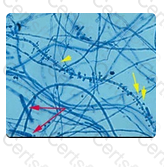AHG must be added to the cells immediately following washing. Antibodies may elute from the cells if the cells are allowed to sit in saline without the addition of AHG.
Which one of the following may cause a FALSE-NEGATIVE result with antiglobulin techniques?
The lecithin-sphingomyelin ratio is a test for assessing fetal lung maturity that is useful in determining risk of an infant born with respiratory distress syndrome.
The Lecithin/Sphingomyelin ratio determination of amniotic fluid is useful in assessing the probability of:
The correct answer is Trichophyton rubrum. The tiny microconidia are lined up in a "birds on the fence" arrangement along the hyphal strand transversing the field of view (yellow arrows). Two pencil-shaped, smooth walled macroconidia are also seen in the lower left field of view (red arrows).
Trichophyton verrucosum may produce microconidia in small quantities. However, they are irregularly arranged with little tendency to line up along the hyphae. Antler hyphae and string bean macroconidia are characteristic of this species.
One of the key characteristics in the identification of Epidermophyton floccosum is the inability of this dermatophyte to produce microconidia. Two to four-celled, club-shaped macroconidia are produced, usually in clusters of two or three.

The profusion of tiny microconidia lining up along the hyphae in this photomicrograph is characteristic of which of the following organisms?
Oxalate, EDTA, and citrate are anticoagulants that inhibit clot formation.
Which of the following blood additives is most useful for serum collection:
Blood bank
Once the seal on a unit of packed red cells is broken, how long can the unit be stored refrigerated prior to administration:
The Clinical Laboratory and Standards Institure (CLSI) recommends that all patient specimens are delivered to the laboratory no more than 2 hours after collection to reduce pre-examination variables caused by cellular action and the effects of prolonged exposure of specimens to room temperatures, such as:
Question options:
Unexplained bleeding is associated with immediate hemolytic transfusion reactions, but is not usually associated with delayed hemolytic transfusion reactions. The bleeding results from disseminated intravascular coagulation (DIC) due to ABO antibodies causing intraventricular hemorrhage (IVH).
Which of the following signs and symptoms may be associated with immediate transfusion reaction, but is NOT usually associated with delayed hemolytic transfusion reaction?
Unconjugated bilirubin is a byproduct of RBC breakdown, or hemolysis. It would be expected to see an increase in unconjugated bilirubin when hemolysis is occuring at an increased rate. The liver enzymes would not remain at normal levels if there were a viral infection of the liver, chemical damage to the liver, or obstruction of bile ducts.
Chemistry
A patient presents with an elevation of unconjugated bilirubin, normal serum alkaline phosphatase, normal liver enzymes, and no bilirubin in the urine. This combination would suggest:
The correct set of patient data would be: Hgb A = 60%, Hgb S = 38%, Hgb A2 = 2%, Hgb F = 0%
Patients with sickle cell trait commonly have Hgb A values between 40 and 60%, Hgb S values between 20 and 40% and Hgb A2 values between 2 and 3%.
A known sickle cell trait patient has a hemoglobin electrophoresis test performed. Which of the following hemoglobin percentage sets would most closely match this patient's diagnostic state?
Insulin is the hormone that is mainly responsible for the entry of glucose into the cell for energy production
Glucagon and epinephrine promote glycogenolysis, conversion of glycogen to glucose, which increases plasma glucose. Cortisol, along with glucagon, increases gluconeogenesis, formation of glucose from noncarbohydrates, which also raises plasma glucose concentration.
Chemistry
Which of the following hormones is mainly responsible for the entry of glucose into the cell for energy production?
The concentration of circulating ferritin is proportional to the size of iron stores.
Which of the following will give the best overall picture of a patient's iron stores:
Which of the following could reduce the risk of a patient becoming infected with a hospital acquired infection?
Most anticoagulants in blood collectiong tubes prevent clotting by:
Question options:
The laboratory is under the direction of a:
Hemolytic transfusion reactions seldom occur because the incidence of unexpected antibodies in random patients is relatively low, e.g., 3-5% is sometimes cited.
Being transfused with O Rh negative RBC is irrelvant if you have an unexpected antibody like anti-K or anti-c.
Incompatible red cells may "bleed out" but only if bleeding is brisk. Even then, a hemolytic reaction may occur later once the patient's antibody rebounds and destroys remaining antigen-positive donor red cells.
It's true that some patients have only cold-reactive antibodies that will not react at body temperature. But this does not explain why warm-reactive red cell antibodies cause few reactions
Why do so few patients transfused with un-crossmatched red cells in an emergency experience a hemolytic transfusion reaction? Select the one best reason.